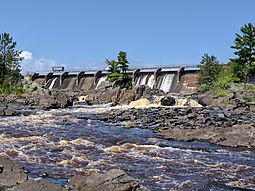Thomson Dam (Minnesota) facts for kids
Quick facts for kids Thomson Dam |
|
|---|---|

Downstream face of the main Thomson Dam on the St. Louis River in 2017
|
|
| Location | Carlton County, Minnesota, U.S. |
| Coordinates | 46°39′59.10″N 92°24′25.80″W / 46.6664167°N 92.4071667°W |
| Purpose | Power |
| Status | Operational |
| Construction began | 1905 |
| Opening date | 1907 1914-48 expanded 2012 damaged 2014 reconstructed |
| Owner(s) | Minnesota Power |
| Dam and spillways | |
| Type of dam | Earth Embankment, Concrete Gravity, Arch |
| Impounds | Saint Louis River |
| Height | Main: 15 ft (4.6 m) Canal: 45 ft (14 m) |
| Length | Main: 1,600 ft (490 m) Canal: 3,500 ft (1,100 m) |
| Spillways | 2 |
| Spillway type | gated |
| Spillway capacity | 60,000 cu ft/s (1,700 m3/s) |
| Reservoir | |
| Creates | Thomson Reservoir |
| Total capacity | 4,352 acre⋅ft (5,368,000 m3) |
| Catchment area | 9,154 sq mi (23,710 km2) |
| Surface area | 649 acres (263 ha) |
| Power station | |
| Name | Thomson Hydro |
| Coordinates | 46°39′17.91″N 92°20′1.032″W / 46.6549750°N 92.33362000°W |
| Hydraulic head | 375 ft (114 m) |
| Turbines | 6 |
| Installed capacity | 72 MW |
| Annual generation | 280 GWh |
| Website http://mphydro.com/ |
|
The Thomson Dam, also known as the Thomson Hydro Station, is a large dam system in northeastern Minnesota, United States. It sits on the Saint Louis River, near the town of Thomson. This important structure helps control the river and create the Thomson Reservoir.
The dam is made up of a main part that is 1,600 feet (488 meters) long. There are also many smaller dams and natural rock formations that help hold back the river. The tallest part of the dam complex is about 51.6 feet (16 meters) high. The longest section stretches for 3,500 feet (1,067 meters).
The Thomson project is very important for making electricity. It uses a series of gate houses, a canal, and underground pipes called penstocks. These carry water to a hydropower plant located 3 miles (4.8 km) away. This plant is the largest hydroelectric facility in Minnesota. It can produce 72 megawatts of power. Each year, it generates about 280 gigawatt-hours of electricity.
Contents
History of Thomson Dam
Building the Dam
The Thomson Dam was finished in 1907. It was built by a company called Great Northern Power. This company was part of the Great Northern Railway.
Growing the Power Plant
The power plant at Thomson Dam grew over time. In 1914, a fourth power-generating unit was added. A fifth unit was installed in 1918. The sixth and final unit was put in place in 1948. Special railroad tracks were built right into the plant. This made it easier to install and fix the heavy equipment.
Later, the dam complex was taken over by the Saint Louis Power Company. Today, it is owned by Minnesota Power. This company is a part of Allete, Inc.
Damaged by Floods
In June 2012, very heavy rains caused a huge flood in the area. The water went over the top of the dam. It also broke through the canal that feeds the power plant. This caused serious damage to the hydroelectric station.
Rebuilding and Upgrades
It cost $90 million to rebuild and upgrade the dam. A new emergency spillway was added to help with future floods. The power plant started working again in November 2014. More upgrades continued until 2018. These included removing old power lines and adding newer, more powerful equipment.
How the Thomson Dam Works
The Thomson Project is more than just one dam. It is a system of many dams and control structures. Over the years, some of these have been rebuilt or joined together. The United States Army Corps of Engineers keeps a list of dams. They count 18 different structures as part of the Thomson complex. Fourteen of these are officially listed as separate dams.
The main dam holds back the Saint Louis River. This creates the Thomson Reservoir. From the reservoir, water flows through a canal. This canal leads to a special area called a forebay. From the forebay, large pipes called penstocks carry the water downhill.
The water rushes through these pipes to the power plant. Inside the plant, the force of the water spins large turbines. These turbines are connected to generators. The generators then create electricity. This process is called hydroelectric power. It is a clean way to make energy using the natural flow of water.
Key Structures of the Dam System
Here are some of the main parts of the Thomson Dam system:
| Dam ID | Name | Height | Width | Type |
|---|---|---|---|---|
| MN00604 | Thomson Dam (Main) | 15 ft (4.6 m) | 1,600 ft (490 m) | Earth Embankment and Concrete Gravity |
| MN00604 | Thomson Canal Dam | 45 ft (14 m) | 3,500 ft (1,100 m) | Earth Embankment |
| MN83026 | Thomson Dam #6 | 51.6 ft (15.7 m) | 125 ft (38 m) | Concrete Arch |
| MN83030 | Thomson Dam #11 (Upper Gate House) | 17 ft (5.2 m) | 365 ft (111 m) | Concrete Gravity |

